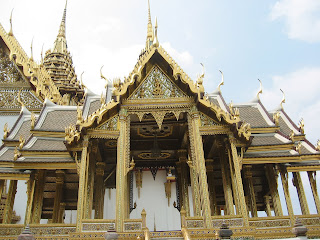Grand Palace and Emerald Buddha

The King, Rama IX, is much loved and respected in Thailand. To show their support of the king, local people wear bright yellow, the king's colour, and we saw it on people everywhere. They believe their kings are reincarnations of Vishnu, and Rama IX is his 9th reincarnation. Rama IV, by the way, was the king from Anna and the King of Siam fame and the great grandfather of the present king.
Royal Avenue, which leads to the Grand Palace, has huge ornate gold leaf frames on either side of the street with photos of the king and queen. One shows him greeting King Hussein of Jordan. Others show the king and queen dressed in royal costume and presiding over kingly functions.
The Grand Palace no longer serves as the residence for the king and queen, who live in a "new" palace built 200 years ago with their white elephant, now 55. Yes, the white elephant lives in the palace. Well, I hope he's in a stable. He's a descendent from the famous while elephant used by early kings for ceremonial purposes and this is also the current elephant's function. He lives a life of ease.
Within the compound of the grand palace, which covers an sizeable 218,000 sq. metres, lies the Royal Monastery of the Emerald Buddha, one of the most venerated sites in Thailand. It's available to all Thais to convene and pay respect to the Lord Buddha and his teachings.
The Emerald Buddha sits on a golden throne made of gilded carved wood about 25' high. The Buddha himself is carved from a single piece of deep green jade and was discovered in 1434 in Chiangrai, covered in plaster. When some of the plaster chipped off revealing the green stone, the abbot who discovered it thought the stone was emerald, and thus the legend.
Speaking of monks, many young Thai men at the age of 20 are ordained into the monkhood by serving for a minimum of 2 weeks or up to 3 months as a monk. During this time they rise at 4:00 a.m., wrap themselves in one single piece of cloth - no underwear - (2 square metres in the case of our guide Poon) and walk the streets. If they are lucky, and they usually are, someone will give them food. They may eat until 12:00 and then no food is allowed to be consumed again until the next morning. They can have beverages, but the afternoon is is the time they devote to study.
Bangkok has 12 million people, and not a few of them eke out a living in shanty towns which spring up wherever there's enough space for them to prop up a shelter. There's huge poverty and unemployment. The streets and canals in these area also serve as refuse piles and there's a lot garbage strewn around. It's sad to see. I saw no people there - they must be out doing what they can to earn a living.
Royal Avenue, which leads to the Grand Palace, has huge ornate gold leaf frames on either side of the street with photos of the king and queen. One shows him greeting King Hussein of Jordan. Others show the king and queen dressed in royal costume and presiding over kingly functions.
The Grand Palace no longer serves as the residence for the king and queen, who live in a "new" palace built 200 years ago with their white elephant, now 55. Yes, the white elephant lives in the palace. Well, I hope he's in a stable. He's a descendent from the famous while elephant used by early kings for ceremonial purposes and this is also the current elephant's function. He lives a life of ease.
Within the compound of the grand palace, which covers an sizeable 218,000 sq. metres, lies the Royal Monastery of the Emerald Buddha, one of the most venerated sites in Thailand. It's available to all Thais to convene and pay respect to the Lord Buddha and his teachings.

The Emerald Buddha sits on a golden throne made of gilded carved wood about 25' high. The Buddha himself is carved from a single piece of deep green jade and was discovered in 1434 in Chiangrai, covered in plaster. When some of the plaster chipped off revealing the green stone, the abbot who discovered it thought the stone was emerald, and thus the legend.

Speaking of monks, many young Thai men at the age of 20 are ordained into the monkhood by serving for a minimum of 2 weeks or up to 3 months as a monk. During this time they rise at 4:00 a.m., wrap themselves in one single piece of cloth - no underwear - (2 square metres in the case of our guide Poon) and walk the streets. If they are lucky, and they usually are, someone will give them food. They may eat until 12:00 and then no food is allowed to be consumed again until the next morning. They can have beverages, but the afternoon is is the time they devote to study.
Bangkok has 12 million people, and not a few of them eke out a living in shanty towns which spring up wherever there's enough space for them to prop up a shelter. There's huge poverty and unemployment. The streets and canals in these area also serve as refuse piles and there's a lot garbage strewn around. It's sad to see. I saw no people there - they must be out doing what they can to earn a living.


Comments